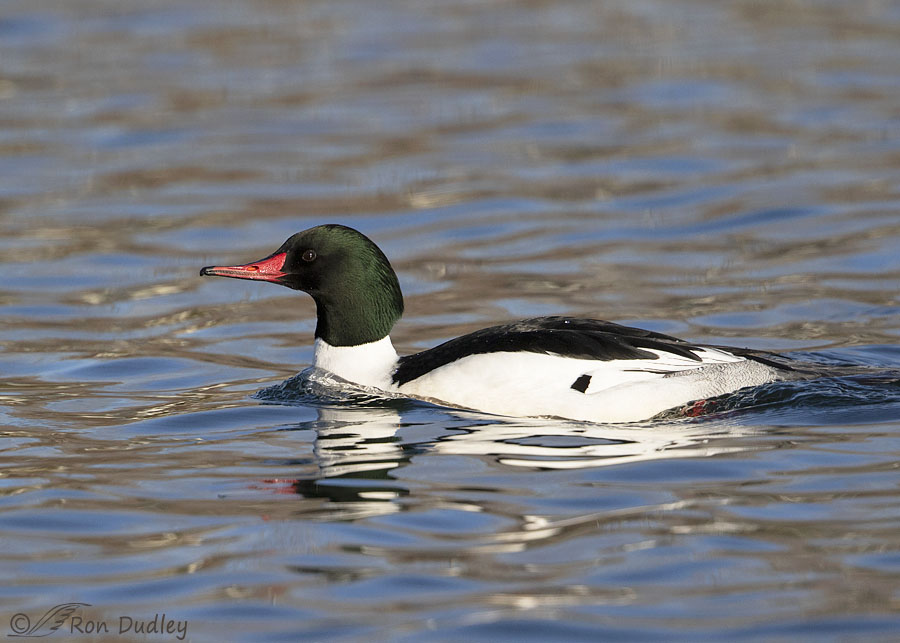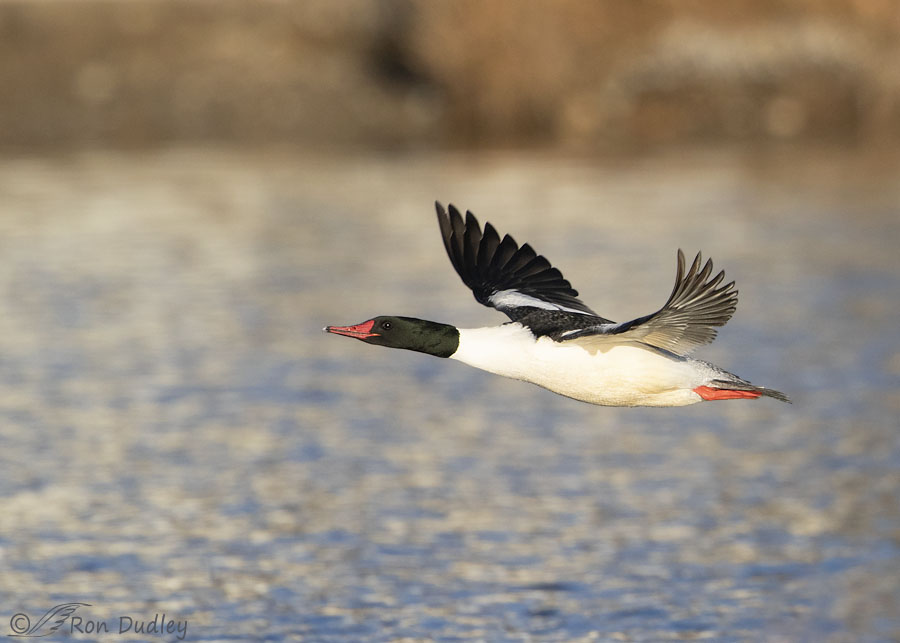I find photos of ducks in flight difficult to come by and because of their speed mergansers are among the most challenging of all.

1/5000, f/6.3, ISO 640, Canon 7D Mark II, Canon EF 500mm f/4L IS II USM + EF 1.4 III Extender, not baited, set up or called in
Usually I have a tough time getting close to Common Mergansers but four days ago this adult male unexpectedly came in so close he almost filled my viewfinder.
Black and white birds are difficult to expose properly almost by definition but the unusually brilliant whites of this species make them even more challenging. So I was happy to get a pretty good exposure on him that included his head turned at just the right angle to the sun to light up his iridescent greenish-black head and upper neck. More often than not their head just looks black.
But I find flight shots of Common Mergansers to be infinitely harder. They’re very fast flyers which makes them tough to track with a long lens and they usually don’t give any indication of imminent takeoff. So 35 minutes after this shot was taken…

1/4000, f/6.3, ISO 640, Canon 7D Mark II, Canon EF 500mm f/4L IS II USM + EF 1.4 III Extender, not baited, set up or called in
I was delighted to get this pretty decent flight shot of another male as he flew low over the pond. He was one of several males flying in single file and I was able to lock on to him just long enough to get a single sharp photo. All the other shots in the burst were soft, a little or a lot.
Common Mergansers are fast flyers but the closely related Red-breasted Mergansers are faster. The fastest duck ever recorded was a male Red-breasted Merganser that attained a top airspeed of 100 mph while being pursued by an airplane. This eclipsed the previous duck speed record held by a Canvasback clocked at 72 mph. I don’t see Red-breasted Mergansers all that often but one of my goals is to get a sharp and detailed photo of one in flight.
Don’t hold your breath.
Ron
Notes:
- In the original photo (the second one) there was part of a coot poking into a corner of the frame but I made ‘him’ disappear. I hope that doesn’t become a habit…
- If you’re interested here’s a link to a full description of what happened when the Red-breasted Merganser flight speed record was documented:


You nailed your target! I didn’t know ducks flew that fast but it makes sense of why Peregines need to be so fast.
The colors of the rings on the bills of the 2 drakes is reversed – the sedentary one has black at the tip with lighter gray closer to the head whereas the flyer has white at the tip followed by a black ring.
Interesting observation about their bills, Pam. That tip of the bill is called the nail.
Add me to those who had no idea of just how fast ‘just’ a duck could fly.
Beauty, education and wonder keep me coming back here – and there is often some laughter thrown in.
Mega thanks. Again.
EC, I knew that many ducks were very fast but like you I was unaware that at least one of them can reach the century mark in mph.
That 35 minute wait really paid off. Hope there was a doughnut involved to help pass the time.
I don’t know exactly how fast a bat out of hell takes off, but Red-breasted Mergansers are pretty common around here and I think their takeoff may beat the bat.
I checked your last post of a Common Merganser. I hope that one-legged one is still around. Also, that post was taken last February so it may be time to make some more cheese manicotti.
Lyle, I only eat a donut on mornings when I go shooting. These photos were taken in late afternoon.
It’s crazy that you mentioned cheese manicotti today. I haven’t made it in many months but I’m planning on making it this afternoon. No kidding, I bought all the ingredients a couple of days ago. You’re prescient!
They are beautiful, I wish they were more common year round. I had no idea they flew that fast!
You’re right, I never see them around here except in winter. But I do see them in MT sometimes in the summer.
Poof coot! You are gone. I think you are hurting the feelings of photobombers everywhere.
I think you are hurting the feelings of photobombers everywhere. 
Arwen, I have to admit that I won’t lose any sleep over hurting that coot’s feelings. But I might for cloning…
Why am I laughing so hard at your postscript comment, “… but I made ‘him’ disappear”?? It really made me LOL. (Also, I seriously doubt such behavior will become a habit.)
Those are two beautiful ducks — neither of whom I would ever suspect were capable of flying even half as fast as a Peregrine! (And of course, that clocked Merganser wasn’t stooping on prey—so really impressive!)
Chris, I think I subconsciously was trying to avoid using the word ‘cloning”.
Great reward for your efforts on both shots. With nice catch lights in both birds, I don’t know if it would get much better than this. Thanks for sharing.
Thank you, Jim.
My first thought was how aerodynamic he looks in flight. Even looks that way in the water. Excellent photography especially showing the green head that as you say so often looks black. We have lots of both Common and Hooded Mergansers here, but the Red-breasted are not as common,
They give me the same impression, Everett – streamlined to the hilt, whether in flight or not.
He is a stunner, beautifully captured. Very nicely done, Ron. Thank you!
Thank you, Diane.
You have all my respect, Ron. The ducks in flight are so challenging. Your photos are very sharp. Thanks to present.
Much appreciated, Laval.
I’d say challenge accepted and met.
Thanks, Steve. Maybe one day the same thing will happen with the Red-breasted Merganser challenge. Or maybe not…
Thanks for the clarification link……I really appreciate how often you add
these things for your followers’ benefit.
Thanks. Didn’t want to leave the wrong impression.
Kris, I’ve now added that link to the bottom of my post so that others won’t have the same impression.
NICE! The Mergansers certainly don’t tend to come close or hold still. Even their “running” on water is speedy…….. Both shots do the bird justice in my opinion……
Both shots do the bird justice in my opinion……
Thank you, Judy.
Longtime lurker, first-time poster here. I was struck by your merganser’s body shape, from bill to feet, like a perfectly streamlined missile piercing the air. Perhaps that could explain this handsome boy’s speed. Love your work.
Welcome to commenting, Kathy. Yes, I was also struck by the aerodynamic shape of their body. In fact I very nearly mentioned it in my post.
Both shots are VERY HANDSOME, in my opinion . Why on earth would
an airplane “pursue” a bird in flight ? Just curiosity to see how far an
animal could be pushed ? and if so– shameful !
Kris, the “pursuit” really wasn’t what it sounds like it was. A full explanation of what happened can be found here:
https://sora.unm.edu/sites/default/files/journals/condor/v063n03/p0265-p0265.pdf
According to this link, the bird’s air speed was 80 mph. Its ground speed was 100 mph because the air was blowing in the same direction as the bird (and the airplane). I don’t mean to diminish the bird’s accomplishment, 80 mph is awesome, but IMHO the bird doesn’t deserve credit for the speed of the air over the ground.
Good point, Phil. It was 100mph ground speed, not air speed.